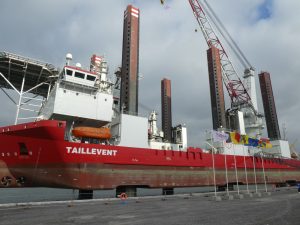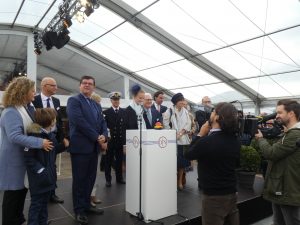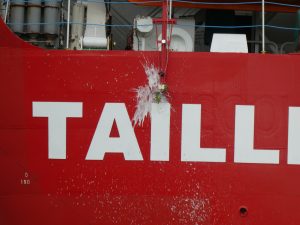Jan De Nul Names Offshore Installation Vessel Taillevent

In the Belgian port of Ostend, Jan De Nul Group named today its newest offshore installation vessel Taillevent. Miss Pauline Stassijns, granddaughter of Director Dirk De Nul, baptised the vessel and wished her success and a safe journey. The De Nul family, employees and their guests attended the christening.
On 18 July 2018, Jan De Nul Group acquired this offshore installation vessel, at that time MPI Discovery, from the Dutch company Vroon Group. The 2011 built Taillevent is designed specifically for the transport and installation of offshore wind turbines and their foundations. It is also perfectly suited to other offshore sectors, such as the oil and gas industry. The vessel is equipped with six spuds to lift the vessel out of the water in order to be able to work in stable conditions. The Taillevent is 140m long and can operate in up to 40m of water depth. Furthermore, this installation vessel has an on-board crane with a lifting capacity of 1,000t and an auxiliary crane of 50t. Among the guests was Bart Tommelein, Flemish Vice Minister-President of the Flemish Government, Flemish Minister for Budget, Finances and Energy, a supporter of green energy production, who gave a speech: “The offshore sector is important for our Belgian economy. Thousands of jobs derive directly or indirectly from the construction and maintenance of offshore wind turbines. Not only in our country, but also worldwide. I am happy to welcome the Taillevent of Jan De Nul Group as a new asset in our switch to renewable energy.”
Jan De Nul Group is investing heavily in its offshore activities and can offer the sector a reliable answer to their pioneering projects. Philippe Hutse, Offshore Director at Jan De Nul Group: “We have been investing a lot in staff, expertise and equipment for our offshore activities. In 2015, we acquired the Vole au vent, and this summer the Taillevent; both specialised vessels for the installation of offshore windfarms. Meanwhile our newbuilding department works on more fleet expansion plans. These investments are key for Jan De Nul Group’s growth.” Jan De Nul Group has executed several offshore wind projects in Belgium, the United Kingdom, Sweden, Denmark, Finland and Germany. Last spring, Jan De Nul secured its first offshore wind projects outside Europe: the design and installation of the offshore windfarms Changhua and Formosa 1 Phase 2, the very first offshore windfarms in Taiwan. More specifically in Belgium, Jan De Nul installed the Nobelwind farm with 50 turbines of 3.3MW each in 2016. In 2019, the Group will commence with the installation of the Northwester 2 windfarm with 23 turbines of 9.5MW each, the largest offshore wind turbines in the world. Peter De Pooter, Manager Offshore Renewables at Jan De Nul Group: “The Taillevent is complementary to our Vole au vent and will enable us to further develop and expand our offshore wind expertise. Having two offshore installation vessels in our fleet, we can serve the industry better and respond more quickly to needs. We already executed a number of comprehensive wind projects in Europe and look ahead with confidence and enthusiasm.”
Today, Jan De Nul Group also celebrates a remarkable character from the past: Taillevent. Until recently, if you google the name, you will find a two-star restaurant with a legendary wine cellar in Paris. However, if you scroll a bit further, you will understand that the restaurant was named Taillevent for good reasons. Indeed, Taillevent was a chef who played a very prominent role in French culinary history. Taillevent. An alias you have to earn. Guillaume Tirel, the Bocuse of the fourteenth century, was nicknamed as such working as a kitchen aid at a young age. Taillevent literally means ‘cutting the wind’. A name they gave him because of the agility with which he flashed through the kitchen. Around 1380, Taillevent wrote one of the oldest and most influential cookbooks of France: ‘Le Viandier’ considered as the basis of the renowned French gastronomic tradition. Its influence is not only evident in many later cookbooks, but it is also of great importance to gastronomic historians.








